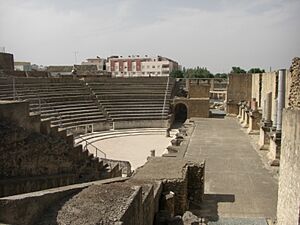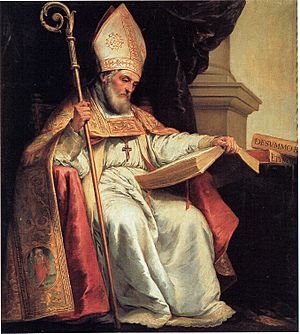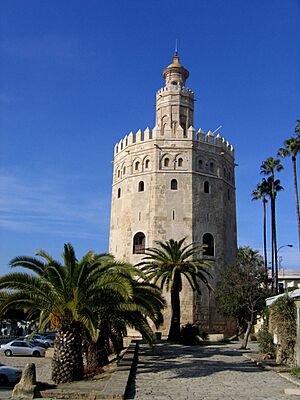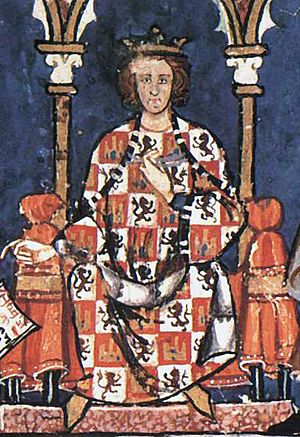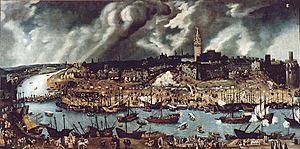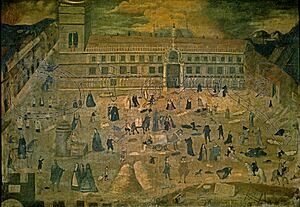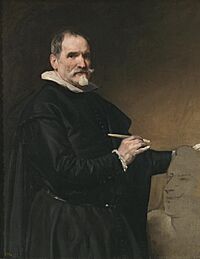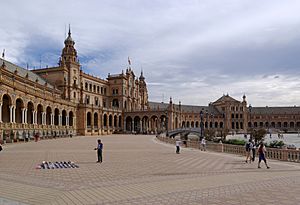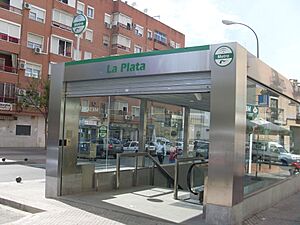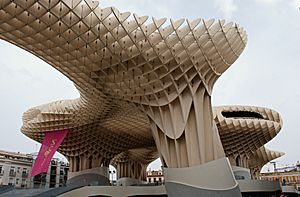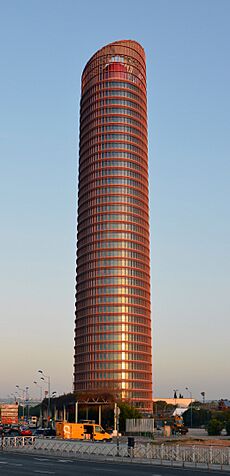History of Seville facts for kids
Seville has been a very important city in Spain for a long time. The first people to live here were the Tartessians. Later, the Carthaginians took over, and then the Romans built a city called Hispalis. This was close to another Roman city, Itálica, which was the birthplace of Roman emperors Trajan and Hadrian. Itálica is still well-preserved today and is a popular place for tourists to visit. When the Visigothic Kingdom ruled, Seville was sometimes their royal home.
Later, during the time of al-Andalus (Muslim Spain), Seville became the capital of a kingdom called the Taifa of Seville. This kingdom was later taken over by the Christian King Ferdinand III. After this, Seville became a major city in the Christian Kingdom of Castile. It was an important trading port, especially for merchants from Genoa. However, the city faced tough times, like the Black Death in 1348.
After the Americas were discovered, Seville became the main economic center of the Spanish Empire. Its port had a special right to control all trade across the ocean. This was a "Golden Age" for Seville, with many advancements in arts and culture. But over time, it became harder for large ships to sail up the Guadalquivir River. So, the trade monopoly moved to Cádiz.
In the 1800s, Seville grew again with new factories and railways. The 20th century brought big changes, including the Spanish Civil War, and important events like the Ibero-American Exposition of 1929 and Expo'92. Seville also became the capital of the Andalusia region.
Contents
Ancient Seville: From Tartessians to Romans

The very first part of Seville was built around 800 BC. It was on an island in the Guadalquivir River. People called Tartessians lived here and named their town Spal or Ispal. They were good traders with the Phoenicians.
Later, the Carthaginians took control of the western Mediterranean. They attacked and destroyed the Tartessian city around 530 BC.
Roman Hispalis: A Busy City
During the Second Punic War, Roman soldiers led by General Scipio Africanus won a big battle near Ispal in 206 BC. This made the Carthaginians leave Spain. Scipio then founded Italica nearby for his veteran soldiers. Italica was a Roman city where important people lived, including future emperors Trajan and Hadrian. Hispalis, on the other hand, became a busy center for craftsmen, trade, and money.
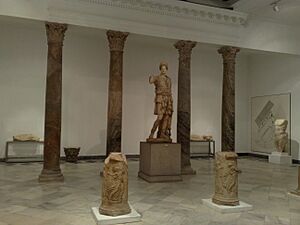
The Romans changed the name 'Ispal' to Hispalis. In 49 BC, Julius Caesar made Hispalis a Roman colony. This was to celebrate his victory over Pompey. The city grew and became one of the most important in Spain. It was a major port for trade.
The main streets of Roman Hispalis met near what is now Plaza de la Alfalfa. This area was the Roman forum, with temples, baths, and public buildings.
Christianity arrived early in Seville. In 287 AD, two sisters, Justa and Rufina, became patron saints of the city. Legend says they were killed for refusing to take part in a pagan festival.
Seville in the Middle Ages
Visigothic Rule: A Royal City
In the 400s, Hispalis was taken over by different Germanic groups. Finally, the Visigoths took control and ruled until the 700s. The Visigothic Kingdom sometimes made Seville (then called Spali) its royal capital.
Two famous Catholic leaders from Hispalis were brothers, Leander and Isidore. Both are now saints. Leander helped convert a Visigothic prince to Catholicism. Isidore wrote a huge encyclopedia called the Etymologies. It contained all the knowledge of the ancient world and was very important in medieval Europe.
Muslim al-Andalus: A Golden Era
In 711, Muslim general Musa bin Nusayr invaded Spain. His son, Abd al-Aziz ibn Musa, took Hispalis in 712 after a long fight. The city became the capital of al-Andalus, which was the Muslim name for the Iberian Peninsula.
The Roman name Hispalis was changed to the Arabic Išbīliya. Under Muslim rule, a rich and complex culture developed. The city was later called Ixbilia in the Mozarabic language, then Sivilia, and finally "Sevilla".
In 756, Abd al-Rahman I took Išbīliya and became the Emir of al-Andalus. The city became part of the Caliphate of Córdoba. The Ibn Adabbas Mosque, built in 830, was the city's main mosque. It is now the Church of San Salvador.
In 844, about 80 Viking ships attacked Išbīliya. They took many people hostage. The emir of Cordoba, Abd ar-Rahman II, fought back, destroying many Viking ships. The Vikings had to make peace and leave. Some Vikings later converted to Islam and settled in the area.
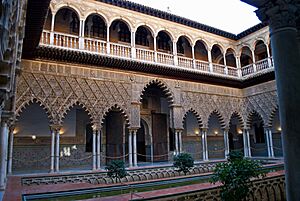
When the Caliphate of Córdoba fell, Ishbilya became independent. It was the capital of a powerful kingdom called a Taifa from 1023 to 1091. The Alcázar of Seville (Royal Alcázars of Seville) was originally a Moorish fort. It is one of the best-preserved Muslim buildings in Spain.
From the late 1000s to the mid-1100s, the Taifa kingdoms were united under the Almoravids and then the Almohads. This was a time of great economic and cultural growth for Ishbilya. Important buildings like the Giralda (the minaret of the great mosque) and the Torre del Oro were built. The Torre del Oro was a military watchtower built around 1200. It was used to control access to Seville from the river.
Christian Conquest: Ferdinand III
In 1247, the Christian King Ferdinand III of Castile began to conquer Andalusia. After a 15-month siege, the city surrendered on November 23, 1248. The great mosque was cleaned and prepared for Christian worship. King Ferdinand III was buried in the new Seville Cathedral. He was known as the "King of the three religions" because he ruled over Christians, Muslims, and Jews. He was made a saint in 1671.
Ferdinand's son, Alfonso X the Wise, continued to make Seville an important capital. He ordered the building of the Gothic Palace of the Alcázar. He also built the Church of Santa Ana, the first Catholic church in Seville after Muslim rule ended. Alfonso X was a great supporter of learning. In 1254, he founded a general school in Seville for Latin and Arabic.
The city's motto, "NO8DO", is a famous legend. It means "It [Seville] has not abandoned me." This motto is believed to have come from Alfonso X, who rewarded the people of Seville for their loyalty to him.
The Black Death in 1348 and a big earthquake in 1356 caused a lot of damage and deaths in Seville. This led to social problems, including a revolt against the Jewish community in 1391. Many Jewish people were killed or forced to convert to Christianity.
In 1478, the Spanish Inquisition was started in Seville to deal with people who were suspected of not being true Christians.
Seville's Golden Age (1500s)
Trade with the New World

The discovery of the Americas in 1492 was incredibly important for Seville. It became the main European port for trade with the New World. In 1503, Queen Isabella I of Castile gave Seville special rights. It was the only port allowed for all trade with the Americas. To manage this, the Catholic Monarchs founded the Casa de Contratación (House of Trade). All voyages and trade had to be approved here. This gave Seville control over the riches coming from the New World.
Seville grew to over 100,000 people, making it the largest city in Spain. It became a very rich and powerful city. A 20% tax, called the quinto real, was collected on all precious metals coming into Spain.
This "Golden Age" brought many artists and writers to Seville. The city became a center for architecture, painting, sculpture, and literature. The printing press also helped spread new ideas.
The University of Seville was officially founded in 1505. There was also a "University of Sea-farers" where pilots and sailors learned about navigation and maps. Famous navigators like Amerigo Vespucci worked here.
Important Buildings of the Golden Age
With all its wealth, Seville built many magnificent buildings.
- The Seville Cathedral was finished in 1506. It is one of the largest churches in the world. The Giralda, the former minaret of the mosque, became its bell tower.
- The General Archive of the Indies holds important documents about the Spanish Empire in the Americas. It is a UNESCO World Heritage Site.
- The Casa consistorial de Sevilla (City Hall) was built in the Plateresque style.
- The Hospital de las Cinco Llagas (Hospital of the Five Holy Wounds) is now the seat of the Parliament of Andalusia.
- The Royal Tobacco Factory (built 1728-1790) was one of the largest industrial buildings in Europe. It is now part of the University of Seville.
- The Casa de Pilatos (Pilate's House) is a beautiful palace mixing Renaissance and Mudéjar styles.
The famous writer Miguel de Cervantes lived in Seville between 1596 and 1600. He even spent some time in prison here due to financial problems.
Later Centuries: Decline and Revival
1600s and 1700s: Challenges and Art
In the 1600s, Seville faced tough times. There was an economic crisis, river floods, and a terrible plague in 1649. The plague killed almost half of the city's population. Many religious convents were built during this time. The famous Holy Week processions also became more organized.
Despite the economic problems, this was a "Baroque golden age" for painting in Seville. Famous artists like Velázquez, Zurbarán, and Murillo were born or worked here. They created beautiful religious paintings and portraits. The Museum of Fine Arts of Seville has many of their masterpieces.
Sculptors like Juan Martínez Montañés and Juan de Mesa also created amazing works. Many of their sculptures are still used in the Holy Week processions today.
The Palace of San Telmo was built in the late 1600s. It was originally a school for orphaned boys who would serve in the navy. Today, it is the seat of the Andalusian Autonomous Government.
In 1717, the Casa de Contratación was moved from Seville to Cádiz. This was because the Guadalquivir River was becoming too shallow for large ships. This greatly reduced Seville's importance in international trade.
1800s: New Growth
In 1800, a yellow fever epidemic killed a third of Seville's population. In 1810, French troops under Joseph Bonaparte occupied the city for over two years. They looted many valuable artworks.
Seville began to grow again in the mid-1800s. The Isabel II bridge (Triana Bridge) was built. Street lighting was improved, and many streets were paved. Railways were built, and parts of the old city walls were taken down to allow the city to expand. The Sevillana de Electricidad Company was created in 1894 to provide electricity.
1900s: Major Events
Preparations for the Ibero-American Exposition of 1929 began in 1910. This was a big world's fair held in Seville. Many beautiful buildings were constructed for the fair, especially in María Luisa Park. Most of these buildings were designed to stay permanently. The most famous is the Plaza de España, designed by Aníbal González. It's a huge half-circle with buildings and bridges over a moat.
In 1931, Spain became a republic. The Spanish Civil War started in 1936. Seville was quickly taken by General Gonzalo Queipo de Llano and became an important base for the Nationalist army. Many people were killed during this time.
Under Francisco Franco's rule (1939-1975), Seville, like the rest of Spain, was mostly isolated. In 1961, the city suffered terrible floods when the Tamarguillo river overflowed. Many neighborhoods were underwater, and Seville was declared a disaster zone.
In the 1970s, trade unions began to organize in Seville, even though it was illegal.
After Franco's rule ended, Spain became a democracy. In 1979, Seville held its first democratic local elections.
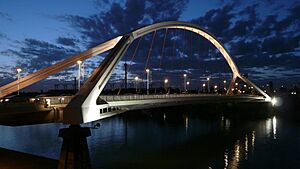
In 1992, the Universal Exposition was held in Seville. This led to huge improvements in the city's transport. A new beltway, new highways, and a high-speed train (AVE) to Madrid were built. The Seville airport was expanded. New bridges, like the Puente del Alamillo and the Puente de la Barqueta, were built to connect to the Expo site on La Cartuja island. After the Expo, the site became a technology park.
2000s: Modern Seville
In the 2000s, Seville continued to develop. Construction of the Seville Metro system was restarted in 2003 after being stopped years earlier. The metro aims to connect the city and its surrounding areas.
Seville has also focused on modern projects. A network of bike paths was built, making Seville a leading city for cycling in Spain. The Plaza Nueva and Constitution Avenue were made pedestrian-only. New architectural projects like "The Setas" (Metropol Parasol) and the Torre Sevilla office tower changed the city's skyline. The port is also being redeveloped to welcome more cruise ships.
Seville's economy today relies on tourism, trade, technology, and industry.
Population Changes Over Time
| Date | Population | |
|---|---|---|
| 12th century | 80,000 | |
| 1275 | 24,000 | |
| 1384 | 15,000 | |
| 1430 | 25,000 | |
| 1490 | 35–40,000 | |
| 1530 | 50,000 | |
| 1533 | 55–60,000 | |
| 1588 | 129,430 | |
| 1591 | 115,830 | |
| 1597 | 121,505 | |
| 1649 | 120,000 | |
| 1650 | 60–65,000 | |
| 1705 | 85,000 | |
| 1750 | 65,000 | |
| 1800 | 80,598 | |
| 1804 | 65,000 | |
| 1821 | 75,000 | |
| 1832 | 96,683 | |
| 1857 | 112,529 | |
| 1860 | 118,298 | |
| 1877 | 134,318 | |
| 1884 | 133,158 | |
| 1877 | 143,182 | |
| 1900 | 148,315 | |
See also
 In Spanish: Historia de Sevilla para niños
In Spanish: Historia de Sevilla para niños
- Timeline of Seville


